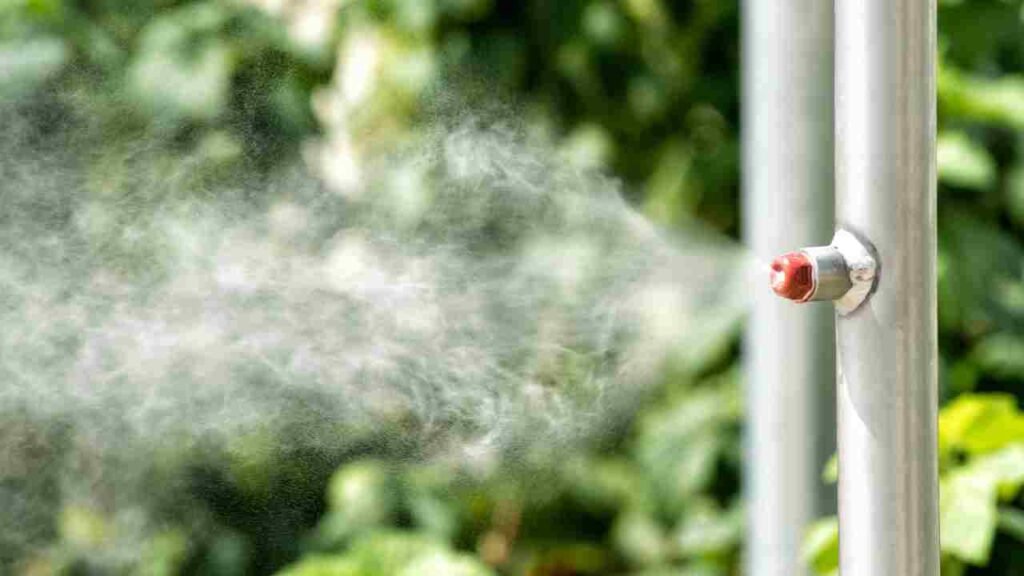
Keeping your mist nozzles in top-notch condition ensures a refreshing and effective misting experience. We all know the frustration of clogged nozzles and lackluster performance, but fear not! In this comprehensive guide, I’ll walk you through the art of cleaning mist nozzles with precision and finesse.
Whether you’re a seasoned misting system owner or a newbie seeking to maximize your misting potential, this blog post is your ultimate go-to resource. Say goodbye to uneven sprays and hello to a revitalizing mist that will leave you feeling cool and rejuvenated. So, let’s dive in and discover the secrets to maintaining pristine mist nozzles for optimal performance.
Signs that Mist Nozzle Needs Cleaning:
Regarding misting systems, keeping a close eye on your mist nozzles is crucial for maintaining efficiency. Here are some telltale signs that indicate it’s time to roll up your sleeves and give those mist nozzles a thorough cleaning:
1. Reduced Mist Quality:
If the fine mist produced by your misting system has become less dense or inconsistent, it indicates that your mist nozzles may be clogged or dirty. A buildup of mineral deposits, dust, or debris can hinder the smooth flow of water, resulting in an unsatisfactory misting experience.
2. Uneven Spray Patterns:
Take a moment to observe the spray patterns created by your misting system. Are they uniform and well-distributed, or do you notice unevenness or spotty coverage? When mist nozzles are clogged, they can disrupt the even distribution of water, leading to irregular spray patterns that may leave some areas dry while saturating others.
3. Decreased System Performance:
Is your misting system not functioning as efficiently as it used to? Are you experiencing a decrease in misting duration or overall output? A dirty mist nozzle can restrict the water flow, causing a decline in system performance.
If you have to run the system for longer periods or encounter decreased misting power, it’s time to give those nozzles some much-needed attention.
Gathering the Essential Cleaning Tools:
Before embarking on the mission to clean your mist nozzles, gathering the necessary tools and materials is important to ensure a thorough and effective cleaning process. Here’s a handy checklist of essential items you’ll need:
- Soft Brush: Opt for a soft-bristle brush, such as a toothbrush or a specialized nozzle cleaning brush. This will help you gently remove any visible debris or mineral deposits without damaging the delicate components of the mist nozzle.
- Vinegar or Mild Cleaning Solution: Prepare a mixture of water and vinegar or use a mild cleaning solution specifically designed for removing mineral buildup. Vinegar is a natural and effective cleaner, dissolving mineral deposits that can clog the mist nozzles and affect their performance.
- Toothpick or Small Needle: These handy tools come into play when it’s time to clear any stubborn clogs within the nozzle openings. Gently insert the toothpick or needle and carefully dislodge any debris that may obstruct the water flow.
- Clean Cloth: Have a clean, lint-free cloth ready to wipe down the mist nozzles after cleaning. This will help remove any remaining residue and ensure they are thoroughly dry before reassembling them into the misting system.
Step-by-Step Guide to Cleaning Mist Nozzles:
Now that you have your essential cleaning tools ready, it’s time to roll up your sleeves and dive into the step-by-step process of cleaning your mist nozzles. Follow these instructions to ensure a thorough and effective cleaning:
1. Turn off the Misting System:
Before you begin, disconnect your misting system from the power source. This is essential for your safety and to prevent accidental spraying during cleaning.
2. Remove the Mist Nozzles:
Carefully remove the mist nozzles from the system. The removal method may vary depending on the specific model of your misting system. Refer to the manufacturer’s instructions to ensure you detach them correctly.
3. Brush Away Debris:
Take your soft brush and gently brush away any visible debris or mineral deposits on the surface of the mist nozzles. Be thorough but gentle, as mist nozzles are delicate and easily damaged.
4. Clear Clogs:
If you notice any clogs in the nozzle openings, use a toothpick or small needle to dislodge them carefully. Insert the toothpick or needle into the openings and gently wiggle it to remove any obstructions blocking the water flow.
5. Soak in Cleaning Solution:
Prepare a mixture of water and vinegar or use a mild cleaning solution. Submerge the mist nozzles in this solution and let them soak for 15-30 minutes. This will help dissolve any mineral buildup or stubborn residue.
6. Rinse and Dry:
After soaking, remove the mist nozzles from the cleaning solution and rinse them thoroughly with clean water. Ensure that all traces of the cleaning solution are washed away. Once rinsed, use a clean cloth to dry the mist nozzles completely.
7. Reassemble the System:
Once the mist nozzles are dry, carefully reassemble them back into the misting system, following the manufacturer’s instructions. Ensure that all connections are secure.
Maintenance :
Congratulations on successfully cleaning your mist nozzles! Now, let’s explore some essential maintenance tips to help you prevent future clogs and ensure the long-term performance of your misting system:
1. Regular Flushing:
Incorporate regular flushing of your misting system as part of your maintenance routine. Flush the system with clean water to remove any residual minerals or debris that may have accumulated over time. This simple step can go a long way in preventing clogs and maintaining optimal performance.
2. Monitor Water Quality:
Pay attention to the water quality you use for your misting system. Hard water with high mineral content can lead to more rapid mineral buildup and clogs. Consider using a water filter or a water softener to reduce mineral deposits and prolong the lifespan of your mist nozzles.
3. Inspect and Replace Worn-out Nozzles:
Periodically inspect your mist nozzles for signs of wear and tear. Over time, mist nozzles may become worn or damaged, affecting their performance. If you notice any deterioration, such as cracks or uneven spray patterns, it’s time to replace them with new ones to maintain optimal misting efficiency.
4. Protect Nozzles from Debris:
Take precautions to protect your mist nozzles from debris, such as leaves, dirt, or insects. Consider installing protective covers or screens over the nozzles to prevent unwanted particles from entering and clogging the system. Regularly clean these covers to ensure unrestricted water flow.
5. Schedule Professional Maintenance:
If you need more clarification about the maintenance process or require a more comprehensive check-up, consider scheduling professional maintenance for your misting system. A qualified technician can inspect, clean, and optimize your system, ensuring it operates at its best.
Following these maintenance tips’ll significantly reduce the risk of future clogs and keep your misting system running smoothly. Remember, a well-maintained misting system not only provides a refreshing mist but also prolongs the lifespan of your equipment. Enjoy the benefits of a reliable misting experience for years to come!
Conclusion:
In conclusion, maintaining clean mist nozzles is essential for an optimal misting system experience. By recognizing the signs of clogged nozzles, gathering the necessary cleaning tools, following a step-by-step cleaning process, and implementing regular maintenance practices, you can ensure that your misting system performs at its best.
Clean mist nozzles provide a refreshing mist, prevent uneven spray patterns, and decrease system performance. So, take the time to care for your mist nozzles and enjoy the benefits of a revitalizing and efficient misting experience for years to come. Remember, maintenance goes a long way in keeping your misting system in top shape and ensuring your ultimate satisfaction.
